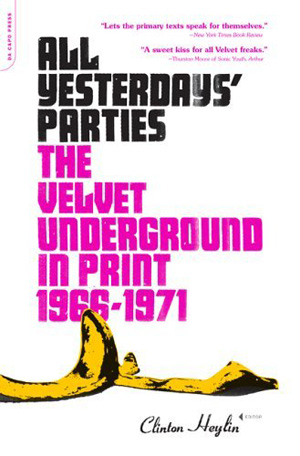 BUY IT AT AMAZON: CLICK HERE!
BUY IT AT AMAZON: CLICK HERE!
PUBLISHER: Da Capo Press
MSRP: $15.95
PAGES: 278
It must
be weird to be present at the birth of something new. I’m not a father, nor do
I have any friends who have spawned, so the closest I’ve come is witnessing the
construction of the Super S’more: twelve graham crackers, eight bars of
Hershey’s chocolate, and a bag of jet-puffed marshmallows. I ate three bites
and vomited.
Since I
don’t have much of my own experience to draw on, I always enjoy being
vicariously present at the emergence of new creatures, from origin stories in
the funnybooks, to novels from the start of the form, to biographies of
important musical groups which broke up before I was born.
All Yesterday’s
Parties is a
variation on the latter. It is a comprehensive history of the Velvet
Underground, but it is not written by a biographer. Instead, it is a
compilation of show reviews, album criticism, and opinion pieces published in a
wide variety of rags (from the Los Angeles Free Press to the New York Times)
which combine to give a variegated, Rashoman-style portrait of the band.
Leading
off the collection is a lengthy introductory essay by editor Clinton Heylin,
which serves to educate the reader in two areas: 1) A survey of the Velvet
Underground’s life as a band, and 2) An example of the mode of pretension that
will frequently occur in the other journalistic samplings throughout the book. I
can’t fault Heylin for his editorial acumen, but the quasi-spiritual ramblings
are far and above any shape of academia. It cheapens, rather than
authenticates, the impact of the band, similar to the way any religious figure loses
appeal in the hysteria of his followers.
Fortunately,
save for some biased interjections now and again, Heylin’s own words don’t
appear much throughout the rest of the pages. The remainder of the book is
organized into years, beginning with the earliest publications regarding public
appearances of the Velvets in 1966. These first entries are only partly
concerned with the band, since during that year they were closely involved with
Andy Warhol and his intermedia show Exploding Plastic Inevitable.
Even in
these early reviews — which are more backhanded condemnations of Warhol’s
pop-art entrepreneurship than show criticism — the number of reactions to the
Velvets are many, ranging from one-sentence acknowledgements of their soup of
sound to glowing dissections of the show, separating the band from Warhol’s trappings
and setting them apart as a distinct reason to take in the Inevitable.
Over the
next year or so, journalists seem to struggle with partitioning off the band as
separate from Warhol’s artistic agenda, but once they do they find a wealth of
material to write on. It’s a testament to the band’s individuality that they
were able to survive the "breakup" with Warhol and move on to greater
things in their own direction. Once they begin recording their seminal albums,
especially "White Light/White Heat," the references to Warhol drop
away and the critics realize that the band has a distinct voice which deserves
more focused analysis.
Heylin
keeps the reading brisk by alternating short and long pieces of criticism. Some
are only scant paragraphs long, others last for upwards of 10,000 words. Some
just seem longer. The historic
picture of the Velvets begins to unfold by the work of many hands as certain publications
remark on their musicianship, others focus on individual members, and still
others hail them as an experience that defines a generation.
While the
former two types of articles are more informative, and give a concrete image of
the band, the latter are far more fun to read. They’re full of name-dropping,
psychotropic prose, bold declarations of the band’s quality, and arguments so
labyrinthine as to make the reader wonder if they’ll ever find the conclusion
or if the minotaur is going to slaughter them first.
That’s a
side-effect of the book that’s really wonderful: instead of just being a
contextual history, it’s also a slice of journalistic archaeology. It’s a blast
to compare the writing styles and memes over the few years the book covers. The
stuffy journalist elite appear alongside the Aquarians; the justified fanatics
share space with the conscientious detractors.
The
trouble with history books tends to be a narrowness of vision. A single
ideology, often from a single person, colors the subjects. The quest for
objectivity breaks down at a nebulous point, the moment data are interpreted. All
Yesterday’s Parties is an edifying book because it approaches
objectivity by involving such a wide variety of subjective views. Though the
editor can in no way be considered an emotionless observer or chronicler of the
Velvets’ history, the content speaks much louder than his editorial voice.
This is
an entertaining and fascinating book, and the great thing is that it can only
hold more appeal for those already in possession of emotional ties to the band
than it did for me, a virtual neophyte.
Judging the Book by its Cover
The Velvets’ first album was
decorated with an iconic banana painted (or at least signed) by Andy Warhol.
This cover is perfect, then, in the irony of turning the fruit into garbage,
moving beyond Warhol’s limiting benefaction. If this book has any sort of a
thesis, that’s a good representation of it.
7.8 out of 10